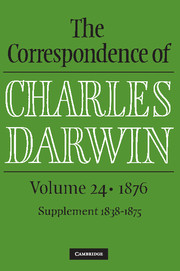Book contents
- Frontmatter
- Dedication
- Epigraph
- Contents
- List of illustrations
- List of letters
- Introduction
- Acknowledgments
- List of provenances
- Note on editorial policy
- Darwin/Wedgwood genealogy
- Abbreviations and symbols
- The Correspondence
- Supplement to the Correspondence, 1838–75
- Appendixes
- I Translations
- II Chronology
- III Presentation lists for Variation 2d ed., Cross and self fertilisation, and Geological observations 2d ed.
- IV Reviews of Cross and self fertilisation
- V Letters regarding the HMS Challenger specimens
- Manuscript alterations and comments
- Biographical register and index to correspondents
- Bibliography
- Notes on manuscript sources
III - Presentation lists for Variation 2d ed., Cross and self fertilisation, and Geological observations 2d ed.
from Appendixes
Published online by Cambridge University Press: 30 December 2016
- Frontmatter
- Dedication
- Epigraph
- Contents
- List of illustrations
- List of letters
- Introduction
- Acknowledgments
- List of provenances
- Note on editorial policy
- Darwin/Wedgwood genealogy
- Abbreviations and symbols
- The Correspondence
- Supplement to the Correspondence, 1838–75
- Appendixes
- I Translations
- II Chronology
- III Presentation lists for Variation 2d ed., Cross and self fertilisation, and Geological observations 2d ed.
- IV Reviews of Cross and self fertilisation
- V Letters regarding the HMS Challenger specimens
- Manuscript alterations and comments
- Biographical register and index to correspondents
- Bibliography
- Notes on manuscript sources
Summary
Darwin began work on the second edition of Variation (The variation of plants and animals under domestication, first published in 1868) on 6 July 1875 (Correspondence vol. 23, Appendix II), having suggested a new edition to his publisher, John Murray, in February (ibid., letter to John Murray, 16 February [1875]). However, Darwin spent much of the spring of 1875 working on Insectivorous plants, which was published in July 1875. Publication of Variation 2d ed. was initially expected in November (Correspondence vol. 23, letter to J. V. Carus, 1 July [1875]), and then December (ibid., letter to J. V. Carus, 14 October [1875]), but was held up by floods at the printers, William Clowes & Sons (letter from H. E. Litchfield to Leonard Darwin, 21 November [1875] (DAR 258: 1648)). It was finally published by the second half of February 1876 (Publishers’ Circular 1876); although it carries an 1875 imprint, it seems that the index did not reach the printer and the number of copies to print was not decided until 1876 (letter from John Murray, 6 January 1876).
Cross and self fertilisation (The effects of cross and self fertilisation in the vegetable kingdom) was Darwin's major publication of 1876. It dealt with themes that he had been working on for years, but in his ‘Journal’ for 1875 (Correspondence vol. 23, Appendix II), he noted that he ‘began’ (that is, started writing for publication) on 1 September. The actual date may have been later, however, since in a letter to Thomas Meehan dated 3 October 1875 (ibid.), he wrote, ‘I have this day begun to prepare for press observations continued for 10 years on the effects of crossing plants.’ He finished the first draft of the manuscript on 5 May 1876 (CD's ‘Journal’ (Appendix II)), and had it copied by a local schoolmaster, Ebenezer Norman (letter from Ebenezer Norman, 15 May 1876). He went over the copy starting on 11 June, and received proof-sheets from Murray on 19 August (CD's ‘Journal’ (Appendix II)). Darwin's recently widowed son Francis worked on the proof-sheets in Wales, where he was staying with his late wife's family. Work on the proof-sheets was completed on 21 October, and the book was printed in December 1876 (DAR 210.11: 6).
- Type
- Chapter
- Information
- The Correspondence of Charles Darwin , pp. 595 - 599Publisher: Cambridge University PressPrint publication year: 2016
- 3
- Cited by



